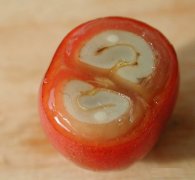Introduction of several kinds of defective beans
Moldy beans: because of incomplete drying, or damp in the process of transportation and storage, cyan and white molds grow, which sometimes make the beans stick together. If these moldy beans are not removed, they will produce moldy smell.
Dead beans: beans with abnormal results. The color is not easy to change because of baking, so it is easy to distinguish. The flavor is thin, as harmful as silver skin, and will become a source of peculiar smell.
Immature beans: beans picked before they are ripe have a fishy, disgusting taste. Leaving raw coffee beans for years is a strategy to deal with these immature beans.
Shell beans: produced by poor dryness or abnormal mating; the beans break from the central line and the inside is turned out like a shell. Shell beans can cause uneven baking and are easy to catch fire during deep baking.
Moth-eaten beans: moths invade and lay eggs when the coffee fruit is ripe and red, and the larvae eat the coffee fruit and grow, leaving traces of moth on the surface of the beans. Worm-eaten beans can cause the coffee liquid to be cloudy and sometimes produce a strange smell.
Black beans: beans that mature early and fall to the ground and ferment and blacken when they come into contact with the ground for a long time. It can be easily removed by hand-selected steps. Coffee mixed with black beans will smell rotten and cloudy.
Shell beans: endocarp covers the inside of the pulp of coffee beans and remains on the washed coffee beans. The poor heat permeability when roasting and sometimes burning is the reason for the astringent taste of coffee. Others include broken beans, red peel beans (beans that rain naturally and taste dull), stunted beans (small grains of beans that stop growing due to lack of nutrients, strong flavor), and sometimes mixed with corn or pepper, and so on.
Stone: beans harvested are easily mixed with stone or sawdust because of natural drying.
Important Notice :
前街咖啡 FrontStreet Coffee has moved to new addredd:
FrontStreet Coffee Address: 315,Donghua East Road,GuangZhou
Tel:020 38364473
- Prev

Coffee training-what is hand-picked beans
Hand selection: is the step of removing impurities and bad beans attached to delicious coffee beans. Coffee beans are often mixed with foreign bodies, such as stones, sawdust, pieces of metal, grains of soil, fruit of trees, and sometimes coins and glass.
- Next

Illustration of coffee | dissection of the internal structure of coffee beans
Coffee bean close-up, coffee bean internal cross-section map of the coffee fruit after the peel of the freshly ripe coffee fruit on the tree, the coffee fruit without the peel, inside two coffee beans with endocarp, silver peel coffee bean coffee fruit internal structure (coffee fruit includes exocarp, mesocarp, pectin layer, endocarp, coffee bean silver skin, endosperm, embryo.) Internal knot of coffee beans
Related
- Guji coffee producing area of Guji, Ethiopia: Humbela, Shakiso, Wulaga
- What is the most expensive variety of Qiloso in BOP multi-variety group?
- How to store the coffee beans bought home?
- Why are Yemeni coffee beans so rare now?
- Ethiopian Sidamo all Red Fruit Sun Sun Santa Vini Coffee beans
- SOE is mostly sour? What does it mean? Is it a single bean? what's the difference between it and Italian blending?
- Is Italian coffee beans suitable for making hand-brewed coffee?
- How to choose coffee beans when making cold coffee? What kind of coffee beans are suitable for making cold coffee?
- Just entered the pit to make coffee, what kind of coffee beans should be chosen?
- Can only Japan buy real Blue Mountain Coffee? What are authentic Jamaican Blue Mountain coffee beans?

